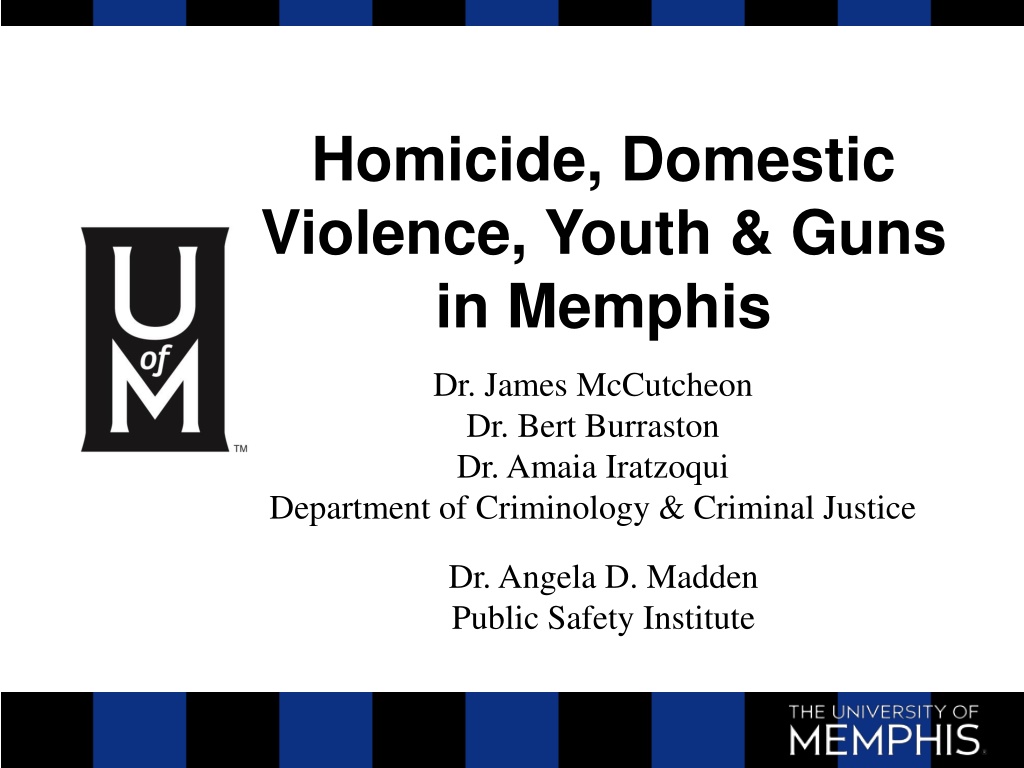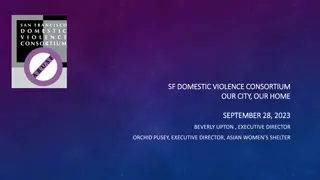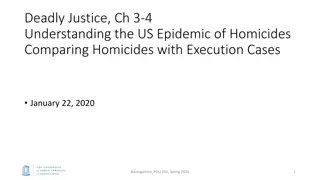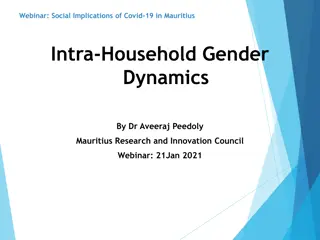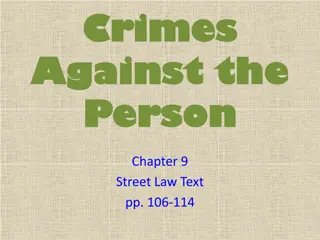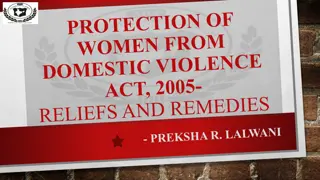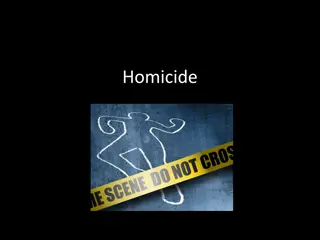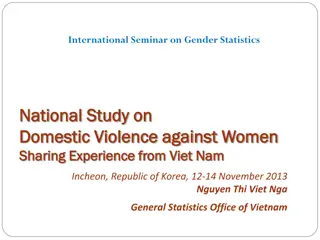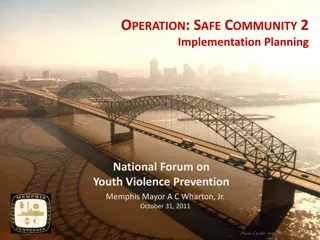Insights on Homicide, Domestic Violence, Youth, and Guns in Memphis
This presentation delves into research findings on homicide, domestic violence, youth, and guns in Memphis, conducted in collaboration with various agencies. The study examines homicide trends, including geographic concentrations and juvenile involvement, shedding light on critical issues impacting public safety in the region.
Download Presentation

Please find below an Image/Link to download the presentation.
The content on the website is provided AS IS for your information and personal use only. It may not be sold, licensed, or shared on other websites without obtaining consent from the author. Download presentation by click this link. If you encounter any issues during the download, it is possible that the publisher has removed the file from their server.
E N D
Presentation Transcript
Homicide, Domestic Violence, Youth & Guns in Memphis Dr. James McCutcheon Dr. Bert Burraston Dr. Amaia Iratzoqui Department of Criminology & Criminal Justice Dr. Angela D. Madden Public Safety Institute
Introduction This presentation results from various research conducted at the request of various agencies and for program development and implementation. Memphis Police Department, Shelby County Sheriff s Office, Shelby County Juvenile Court, Shelby County District Attorney General s Office, Family Safety Center
Study 1: Homicide Research (2016) Homicides and supplemental homicide reports were evaluated and mapped Census tract level data were used along with other socioeconomic factors Education Residential Mobility (movement in and out of neighborhoods)
Census Tracts Showing Deviation from Average in Number of Homicides: Red has the Highest Deviation from Average
Location of Homicides 26% of the homicide incidents within Memphis were within a 1.5 mile proximity of Lamar Ave. This roadway crosses various precincts (Mt. Moriah, Ridgeway, Tillman, Crump, Airways) 14% were in Old Allen 16% were south of I-240, between Bill Morris Pkwy (Hwy 385) and Hwy 78 (Ridgeway and Mt. Moriah)
Lamar Ave. corridor (circled in red) with area between Hwy 385 and Hwy 78 highlighted (circled in black)
Juvenile Violent Crime Counts by Census Tract Legend Count_ 1 - 72 73 - 145 146 - 228 229 - 336 337 - 580
Study 2: Lamar & Juvenile Domestic Violence (DV) About 25% of juveniles brought to juvenile court are brought for DV Home addresses of juvenile DV offenders were mapped 23% of all juvenile DV offenders lived within a 1.5 mile proximity of Lamar Violence is learned in the home, so DV is likely a precursor to neighborhood violence (rates of general violence high where rates of DV high)
Homicides Known Predictors Economic Disadvantage Poverty, Unemployment, Median Income, Median Home Values, % Vacant Homes % Female-Headed Households % Black, % Hispanic Social/Cultural Capital Disadvantage % of population age 25 and over without a high school diploma or GED Residential Mobility % of the population who moved into the census tract between 2010 and 2015
What Predicts Homicide in Memphis? % of population age 25 and over without a high school diploma/GED Juvenile domestic violence Residential mobility % Black residents, but this relationship was weak
What Predicts Homicide in Memphis? Economic disadvantage was not significantly associated with neighborhood homicides Family and child development are important in the development of antisocial and criminal behavior (Social Learning Theory & Social Bond Theory). Neighborhoods with significant populations without an education, with high levels of juvenile DV and high residential mobility (a measure of neighborhood instability) had the highest numbers of homicides.
Homicides and Percent of High School Dropouts 6 5 4 Homicide Count 3 2 1 0 0 2 4 6 8 10 12 Percent High School Dropouts (No GED) 14 16 18 20 22 24 26 28 30 32 34 36 38 40
Study 3: Homicide and Prior DV History (2015-2016)* Was the homicide a DV case ? Did either involved party have a DV history ? 61% of homicides were DV cases and/or involved a party with a DV history. The % would probably have been much higher had we looked back further Only 39% had no DV connection. *30 cases could not be determined
DV History Predicting Homicide 45% Note: A greater percentage of DV homicides had NO DV history than had DV history. 39% 40% 34% 35% 30% 25% 20% 15% 15% 12% 10% 5% 0% DV case with DV history DV case with no DV history Not DV case with DV history Not DV case with no DV history *30 cases could not be classified
Domestic Violence Predicts Homicide A history of domestic violence predicts not only domestic violence homicide but ALL homicide 55% of robbery homicides 51% of disagreement homicides 45% of gang homicides
Implications of Homicide Studies Risk factors for homicides (DV or not) are the same Strategies to prevent homicide must include preventing DV Increase education level in the community Uncovering crime attractors and generators at the city level
Implications of Homicide Studies For police: Crime prevention strategies should extend beyond precinct level Increase communication Interpreting Memphis as a larger unit >City-level crime generators and attractors: streets, interstates, schools, apartments, and other physical features Notice to victims of services available Police as educators of community resources
Implications of Homicide Studies For community: Conflict resolution and domestic violence classes in schools Focus efforts toward high school retention Community GED programs
Study 4: Guns, DV, and youth Firearm violence, domestic violence, and youth involvement were evaluated. Both offenses/reports and arrests were examined. AA/DV: aggravated assault/domestic violence
2016 Violent & AA/DV Offenses/Reports 19% of all violent offenses/reports were for AA/DV. 30% of these AA/DV offenses/reports involved a firearm. Firearm 30% AA/DV Offenses 19% All No Others 81% Firearm 70%
2016 Violent & AA/DV Arrests 26% of all arrests for violent crime were for AA/DV (500/1,915). 25% of these AA/DV arrests involved a firearm (125/500). Violent Crime Arrests AA/DV Arrests Firearm 25% AA/DV 26% No All Firearm 75% Others 74%
Proportion of Gun Arrests* by Age: 2014-2016 70.0 58.4 57.4 60.0 56.1 47.1 50.0 45.2 45.1 40.0 30.0 20.0 12.2 11.3 11.0 10.0 0.0 Juvenile 18-24 2015 Youthful 2014 2016 *includes Weapon/Misdemeanor & Weapon/Felony
Proportion of Juvenile Arrests for Violent* Gun Crime: 2014-2016 18% The proportion of juvenile arrests for violent firearm crime increased 6.7% between 2014 and 2016. 17.4% 17% 17% 17% 17% 16.6% 17% 16.3% 16% 16% 16% 16% 16% 2016 2014 2015 *excludes Weapons/Misdemeanor & Weapons/Felony
Gun Arrests & Violent Gun Arrests by Age: 2014-2016 70.0% 59.4% 57.3% 60.0% 45.9% 50.0% 43.2% 40.0% 30.0% 16.2% 20.0% 11.4% 10.0% 0.0% Juvenile 2014-2016 Gun Arrests 18-24 2014-2016 Violent Gun Arrests Youthful
Gun Crime Recidivists Since 2010 By Age Group (2015 arrestees) 80% 71% 70% 56% 60% 50% 40% 30% 16% 20% 10% 0% Juveniles 18-24 Youthful
Implications Gun violence, DV, youth, and homicide are all connected in Memphis. Juvenile and youthful involvement in violent gun crime is increasing. The proportion of violent crime committed with a firearm has increased nearly 11% since 2013 (from 41.7% to 46.1%). Gun violence prevention, suppression, and intervention programs are critical for youth.
